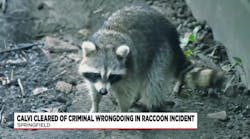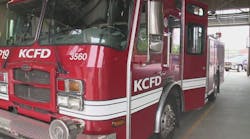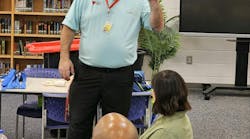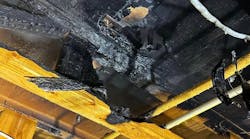From his size-up, Wirkus figured there was a window on each wall. He made it to a window, but it contained an air conditioner that he could not climb over. He tried running to the adjacent wall and hit it directly between the two windows. He landed on his back, lying on his SCBA. He looked up from the floor and saw the flames change direction. He thought the fire had to be going for the air, so he got up and dove in the direction of the flames. He went through a window and landed on a porch roof. A firefighter was standing on the porch roof and was just starting to vent those windows when he saw Wirkus.
Wirkus had been wearing full protective compliant clothing, including a Nomex undershirt, but his best pair of gloves were wet and he had been wearing his backup pair when the incident occurred. Wirkus spoke during Firehouse Expo seminars in Baltimore and Charlotte, describing his experiences and how he survived the flashover.
Jersey City Warehouse Fire. A partially occupied warehouse threatened several nearby exposures in Jersey City on July 15, 1987. I arrived at the fire involving a heavy timber warehouse and parked around the corner adjacent to the building that was located across the street from the fire building. The fire was burning from floor to floor. A pedestrian bridge connected the fire building to the warehouse across the street. Companies were directed to check the bridge to make sure that the fire could not extend across it to the exposure.
As the fire grew in size, units were hastily withdrawn from the front of the building due to the intense radiant heat. The fire started to burn across the top side of the bridge to the exposure. Units inside were unsure if they could hold the fire from entering the exposure. That's when I decided to move my car about two blocks away upwind. The building became fully involved, the fire was held to the exposures and then the building collapsed.
K-Mart Warehouse Fire. A fire in a one-story, 1,250-foot-long and 1,000-foot wide K-Mart distribution warehouse in Falls Township, PA, caused $113 million in damage on June 21, 1982. The fire burned for seven days. The center, one of 10 located across the country, served 382 stores from Maine to Virginia. The building was fully sprinklered, but the fire overwhelmed the system. Aerosol cans spread the fire as they rocketed. The fire was the most costly to strike a single building up to that time. The building was rebuilt to nearly twice its original size.
The fire occurred on a Monday. On Tuesday, I traveled to Cherry Hill, NJ, to write a story about that department's mobile air cascade unit. While I was in Cherry Hill, firefighters told me about a fire in Pennsylvania the day before that caused over $100 million in damage. I told them there was no such thing. On Wednesday, I traveled to the New York State Chiefs show. John Paige, then the editor-in-chief, told me that the fire chief from Falls Township, PA, was attending the show when he was notified of the fire. He responded from upstate New York.
On Thursday, while I was trying to reach any firehouse in Bucks County to confirm reports of the fire, officials called the magazine and said they were still fighting the fire and asked that someone come to the scene and interview them. I traveled to the scene, passing a seven-alarm fire on the way. When I arrived, a portion of the warehouse was still burning. Companies from Pennsylvania and New Jersey were being rotated at the scene.
I was escorted into the rubble and shown where the fire had started. Units initially were backed away from the building. There was no reason to call dozens of engines because even the best streams only reached 100 to 200 feet into the 1,250-foot-wide structure.
Los Alamos Wildfire. A prescribed burn gone astray, the fire gained intensity and bore down on the city and county of Los Alamos, NM, in May 2000. The fire threatened the nuclear lab, which covers 43 square miles. This lab is critical to the national interests of the United States. Hundreds of homes were destroyed after the firestorm gained intensity and spread to the residential neighborhoods near the lab.
After the fire burned into the neighborhood, flames spread from house to house due to nearby vegetation, firewood storage and the large number of trees in the forest. I interviewed members of the department and was given a helicopter ride to view the area of origin and to see how the fire had spread through the dense forest and into the town.
First Interstate Bank High-Rise Fire. The most challenging and difficult high-rise fire in Los Angeles history destroyed five floors of the First Interstate Bank building on May 4, 1988. One person was killed and 37 were injured. It took 400 firefighters from 58 companies, about 40% of the department's on-duty strength, to battle the blaze for about four hours. At the time of the fire, the building was the tallest in Los Angeles. It was 62 stories high and had been undergoing sprinkler installation. The installation was 90% complete, but the system was not in service.
Two task forces, an engine and a squad under the command of 1st Battalion Chief Don Cate responded first. Upon arrival, fire was showing from one entire side of the 12th floor and half of another side. Cate requested five more engines, five more task forces and five more chiefs. The fire was now lapping up to the 13th and 14th floors. Firefighters reported it was tough to walk up the stairs and then fight the fire. They would run out of air, walk down a few flights to take a break and change their air cylinders, then look out the window and see the fire reflecting in the windows across the street. They would go back up, fight the fire again, go back down and take a break, and when they looked out the window the fire was coming out on two floors. Every time they went downstairs, the fire was burning on a higher floor.
A company that was dropped by helicopter onto the roof to look for a trapped occupant said it was easy to walk down to the 50th floor where they found an occupant by a window. They heard radio transmissions from down below and noted that the fire was burning on floors 12, 13, 14 and 15 and rising. They removed the occupant up the stairway 12 floors to the roof. The fire was eventually contained to the 16th floor. Apparently, a delayed alarm caused the fire to gain great headway.
I spoke to Cate and his aide after the fire. When I visited them, they were now working in Battalion 2. I asked why the move? The chief's aide replied that Cate had a fire in the Los Angeles Library that took over eight hours to control. When he was a covering chief, he had a fire that burned through condominiums under construction and threatened a senior citizen nursing home. The aide said they were told if they had any more serious fires they were going to be fired!
Dupont Plaza Hotel Fire. Ninety-eight people were killed when fire ripped through the Dupont Plaza Hotel and Casino in San Juan, Puerto Rico, on Dec. 31, 1986. I heard a news report on the radio while I was in my car. I asked myself, should we go, shouldn't we go? I decided we have to go and cover the story. After New Year's, I went back to work and told the management I was going to Puerto Rico. We are the largest fire service magazine and firefighters are going to want to read about what happened and the lessons learned.
I traveled to Puerto Rico 11 days after the fire. A 20-foot-high chainlink fence had been erected around the entire structure. The burned-out casino was clearly visible from the beach. A roof ladder was still hanging off the top-floor balcony where people were directed to the roof. From there, they were airlifted over several hours to the ground.
I used a friend of a friend as an interpreter to interview the first-in chief, engine company, ladder company and many others who fought the fire. I could not enter the site, but with my interviews with the firefighters an amazing story unfolded. Apparently, the media focused only on the injured and survivors. Not even the local police talked to the firefighters. I wound up with an exclusive story.
Years later, while on my second job, we met some law enforcement people at a crime scene. My partner asked a man who he was and what he was doing at the crime scene. He said he was from the U.S. Bureau of Alcohol, Tobacco and Firearms (ATF) Behavioral Sciences unit and was accompanied by a member of the Royal Canadian Mounted Police. They were taking a year-long course at the FBI Academy and were visiting the NYPD Crime Scene Unit. My partner explained that we had been at the Happyland Social Club fire. The member of the ATF said he was in Puerto Rico at the Dupont Plaza Hotel Fire. My partner told him, so was Harvey. The ATF agent asked, "Is that Harvey Eisner? I want to meet him." The agent greeted me and told me, "Every time I give a talk on the Dupont Plaza fire, I Xerox your story and hand it out!"
Oklahoma City Terrorist Bombing. A tremendous explosion rocked the Murrah Federal Building in Oklahoma City on April 19, 1995. The blast killed 168 people and the resulting search for victims required the department and mutual aid response, including numerous FEMA Urban Search and Rescue teams to remain and operate at the scene for 17 days. We invited Oklahoma City Fire Chief Gary Marrs, who was first on the scene, to make a presentation at the Firehouse Expo in Baltimore. The packed conference room held nearly 2,000 people and after a two-hour presentation Marrs received a 10-minute standing ovation.
Following the Expo, I traveled to Oklahoma City and interviewed Marrs, his assistants and numerous chiefs, officers and firefighters who had operated at different locations in and around the building. I was privileged to be allowed to review notebooks containing hundreds of photos of the initial operations, search and rescue, and recovery operations. I talked with firefighters from Truck 7 who were located south of the explosion. The captain was taking a shower and heard the building shake. He thought the truck had backed into a wall of the fire station. He walked outside and saw the rest of his crew looking north toward downtown and saw the smoke rising. Within minutes, they were responding to the explosion.
Two aerials were raised to the remains of the structure. Truck 7 raised its elevating platform and the crew was ordered to check the building floor by floor for survivors. As they reached the top floors, a firefighter in the bucket told another firefighter to look down at the street - the people were not walking away, or running, they were sprinting away. Just then they received a radio report of a possible second device. They were ordered to leave the area. Firefighters reported that the platform was not moving as fast as they would like. When they reached the ground there wasn't anybody visible for blocks.
We provided unprecedented coverage of the incident in the September 1995 issue. The coverage included how the American fire-rescue service got to where it was at the time of the blast. The blast and search and rescue operations, including the FEMA Urban Search and Rescue teams and how to prepare for a similar incident in the future. Photo coverage included never-before-seen, close-up shots of the rescue operations and damage to the structure, including a two-page photo taken from a helicopter just minutes after the explosion. Marrs told me, "Harvey, the picture I use to show the overall site has a blue tarp that the FBI used to cover ground zero. The picture you used doesn't have a blue tarp. How did you get that photo?"
The photo cost us a lot of money. When I first asked for the authorization to purchase the photo, management was reluctant, suggesting that people were trying to make money off the disaster. I showed a book that covered the bombing, depicting the damaged building, injuries to the children lying in hospitals, funerals, etc. The aerial view was also in this book, which showed the tremendous human impact of the disaster. I was told to purchase the photo.
Los Angeles Riots, April 29-May 3, 1992. I was attending the Congressional Fire Services Institute dinner in Washington, D.C. and I watched live TV coverage of the fires from Los Angeles that night. I tried for weeks to obtain permission to travel to Los Angeles to interview the firefighters who were in the middle of the fires. Finally, I was told I could attend an interdepartmental critique the following week. I sat in on the critique with representatives from neighboring fire departments and law enforcement.
If that wasn't enough, the city suffered a 6-plus earthquake early the next morning, followed by several 4-plus aftershocks. That was about all I could take and wanted to leave immediately. I traveled across the city and saw dozens of burned-out strip malls. The devastation was amazing.
One unusual part of our coverage was a map of the engine company response areas and the number of structural fires that were reported in each district. Another unusual item was the log from a battalion chief who led a task force of five engines. Run after run was listed, with his last entry himself being cut by flying glass after being shot at.
Related:







